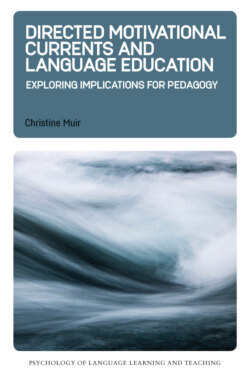Читать книгу Directed Motivational Currents and Language Education - Christine Muir - Страница 6
На сайте Литреса книга снята с продажи.
ОглавлениеFigures and Tables
Figures
4.1 Description of DMCs used in the DMC Disposition Questionnaire
5.1 Duration of the experience for the DMC and general long-term motivation groups
5.2 Ages of respondents within the DMC group versus the sample as a whole
5.3 Age range of respondents in the Never group compared to the sample as a whole
5.4 Language levels at the time that participants experienced this type of motivation in the context of language learning, for those who answered ‘Strongly Agree’ (N = 277)
5.5 Contexts in which DMCs were experienced in the context of language learning, for those who answered ‘Strongly Agree’ (N = 277)
Afterword.1 Sketch of a project on creating a video clip to be used as class material
Tables
3.1 Seven frameworks for focused interventions
4.1 Number of responses from the top 20 most well represented countries (in terms of number of respondents)
4.2 Number of responses broken down by continent
4.3 The age spread of respondents
5.1 Summary of responses to initial questions regarding participants’ recognition and experience of this type of intense motivation
5.2 Summary of responses to the question: ‘How often do you think you have experienced a project to this kind of motivational intensity?’
5.3 Chi-square results: Level of intensity x whether participants would like to repeat the experience
5.4 Results of the exploratory factor analysis (Extraction method: Maximum Likelihood. Rotation method: Oblimin with Kaiser normalisation)
5.5 Results of the exploratory factor analysis with a forced two factor solution (Extraction method: Maximum Likelihood. Rotation method: Oblimin with Kaiser normalisation)
5.6 Descriptive statistics for the four response groups submitted to ANOVA to compare scores on the DMC Disposition Scale
5.7 Descriptive statistics for the four response groups submitted to ANOVA to compare scores in the level of intensity reported
5.8 Descriptive statistics of responses on the DMC Disposition Scale in the general long-term motivation group for each of the seven age groups
5.9 Descriptive statistics of responses on the DMC Disposition Scale from participants in the DMC group for each of the four regrouped age categories
5.10 Chi-square analysis comparing the DMC and general long-term motivation groups by way of the duration of the experience
5.11 Descriptive statistics of the five groups put forward for ANOVA: Both the DMC group and the general long-term motivation group together (N = 1185; 1 = Not very intense, 5 = Very intense)
5.12 Descriptive statistics of the five groups put forward for ANOVA: The general long-term motivation group (N = 655)
5.13 Descriptive statistics of the five groups put forward for ANOVA: The DMC group (N = 530)
5.14 Summary of responses to the question: ‘Have you seen this type of intense motivation in people around you?’
5.15 A 2 × 3 Chi-square analysis between participants’ own experience of DMCs and whether they have witnessed DMCs in others
5.16 Chi-square analysis comparing the DMC group and the rest of the sample by way of the ages of participants
5.17 Nationality make-up of the DMC group and the sample group as a whole for the top 15 most populous nationalities represented
5.18 Nationality breakdown of the top 15 most populous nationalities in the Never group compared to the sample as a whole
5.19 Summary of responses to the statement: ‘I have personally experienced this type of intense motivation specifically while learning a language’
6.1 Group 1: Trigger linked to external influences (positive connotation)
6.2 Group 2: Trigger linked to external influences (negative connotation)
6.3 Group 3: Trigger outcome led
6.4 Group 4: Trigger connected to intrapersonal reasons
6.5 Summary of responses to the question: ‘How did this period of intense motivation begin?’
6.6 Why participants would like to experience this type of motivation again. Group 1: Outcome-based reasons
6.7 Why participants would like to experience this type of motivation again. Group 2: Process-based reasons
6.8 Why participants would like to experience this type of motivation again. Group 3: More intrapersonal reasons
6.9 Why participants would like to experience this type of motivation again. Group 4: General/other reasons
6.10 Summary of responses as to why individuals reported wanting to repeat the experience
6.11 Why participants would not like to experience this type of motivation again. Group 1: Personal emotional/health reasons
6.12 Why participants would not like to experience this type of motivation again. Group 2: Project specific/other reasons
6.13 Summary of responses as to why individuals reported not wanting to repeat the experience
7.1 Overview of student participants
A4.1 Traditional course timetable
A4.2 Lesson outlines for Week 1 of the study described in Part 3
